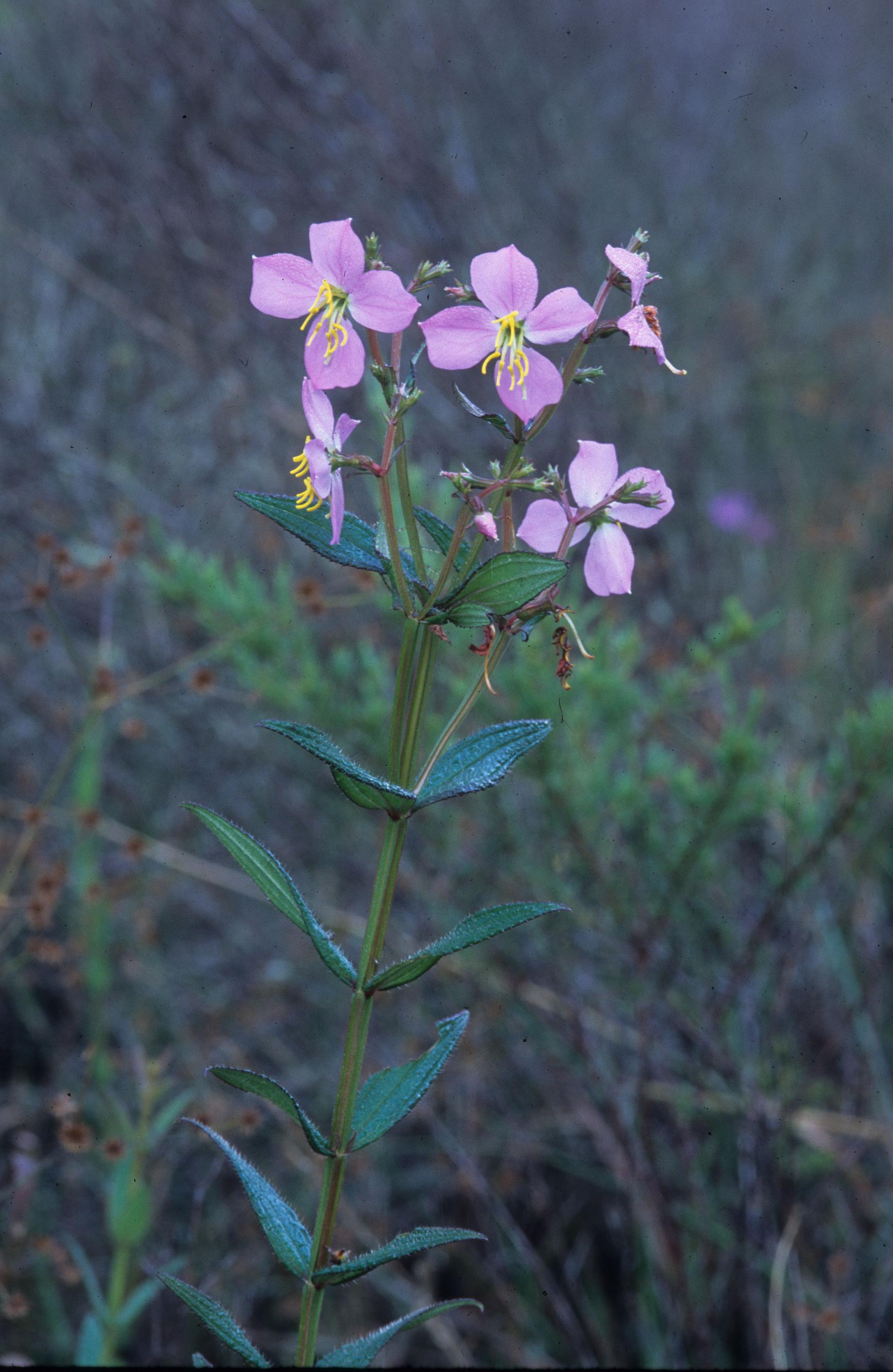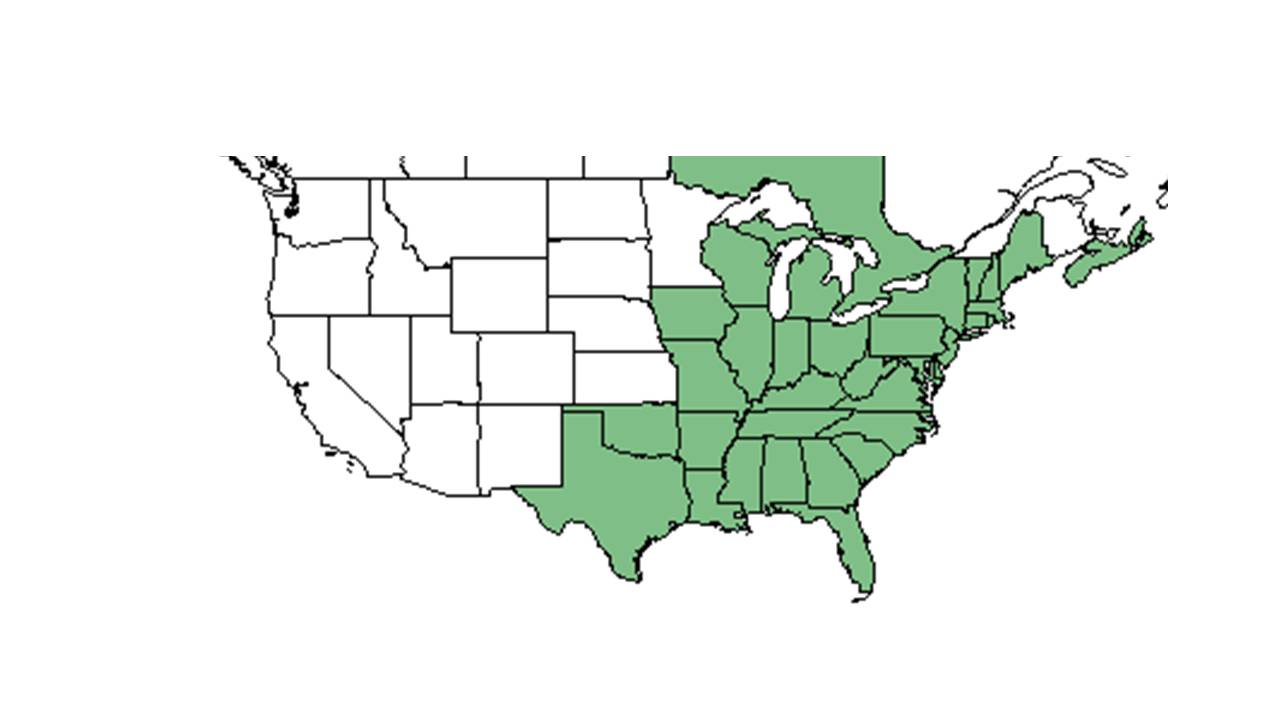Rhexia virginica
| Rhexia virginica | |
|---|---|

| |
| Photo was taken by Gil Nelson | |
| Scientific classification | |
| Kingdom: | Plantae |
| Division: | Magnoliophyta – Flowering plants |
| Class: | Magnoliopsida – Dicotyledons |
| Order: | Myrtales |
| Family: | Melastomataceae |
| Genus: | Rhexia |
| Species: | R. virginica |
| Binomial name | |
| Rhexia virginica L. | |

| |
| Natural range of Rhexia virginica from USDA NRCS Plants Database. | |
Common name: Handsome Harry (Nelson 2006).
Contents
Taxonomic notes
Synonym: Rhexia stricta Pursh; R. virginica var. purshii (Sprengel) C.W. James; R. virginica var. septemnervia (Walter) Pursh
Description
Rhexia virginica is a perennial herbaceous species.
"Erect, herbaceous, hermaphroditic, cymose perennials. Leaves opposite, sessile or petioles to 2 mm long. Flowers 4-merous, floral parts perigynous; stamens 8, anthers 1-locular, poricidal, usually with a basal spur. Capsules globose or subglobose; hypanthium cylindrical in anthesis, urceolate at maturity; stipes or pedicels 2-4.5 mm long; seeds brownish or yellowish, crescent-shape, papillose lined, 0.5-1 mm long except for R. petiolate and R. alifanus." - Radford et al 1964
"Hirsute, usually branched perennial; roots usually tuberous; stems to 9 dm tall, faces equal, winged. Leaves elliptic or ovate, to 7 cm long and 2.6 cm wide, sparsely hirsute, 3-nerved, acute or aristate, ciliate-serrate, base cuneate. Sepals deltoid, 1.5-3 mm long, aristate; petals rose-purple, glandular hirsute marginally beneath, 10-25 mm long, usually mm long, usually glandular hirsute, neck shorter than body." - Radford et al 1964
Distribution
R. virginica is a rare species found in depressional wetlands occurring in Alabama, Georgia, North Carolina, South Carolina, and Virginia (Edwards and Weakley 2001).
Ecology
Habitat
It is found in wet ditches, savannas, flatwoods, and pond margins, and sometimes in standing water (Nelson 2006). It also has been found in cypress-gum swamps, seepage bogs, lake shores, and other poorly drained situations (FSU Herbarium). It seems to prefer partial shade and wet sandy or peaty soils (FSU Herbarium). It can also occur in some human disturbed areas, especially those with wet conditions, including ditches, roadsides, clearings, power line corridors, and drained and bulldozed bogs (FSU Herbarium). Associated species include Eriocaulon, Xyris, Cypress, Liquidambar styraciflua, Cyrilla, Rudbeckia mohrii, Pinus palustris, Pinus taeda, Sarracenia minor, Rhexia cubensis, Eragrostis refracta, Juncus abortivus, Juncus megacephalus, Juncus debilis, Lachnanthes caroliniana, Erigeron vernus, Ludwigia linearis, and Hypericum fasciulatum (FSU Herbarium).
Phenology
It blooms July through October (Nelson 2006). Both fruiting and flowering have been observed in Florida in July through October (FSU Herbarium).
Fire ecology
This species has been found in habitat that burns frequently--longleaf pineland (FSU Herbarium).
Conservation and Management
Cultivation and restoration
Photo Gallery
References and notes
Edwards, A. L. and A. S. Weakley 2001. Population biology and management of rare plants in depression wetlands of the southeastern coastal plain, USA. Natural Areas Journal 21: 12-35.
Florida State University Robert K. Godfrey Herbarium database. URL: http://herbarium.bio.fsu.edu. Last accessed: June 2014. Collectors: Robert Kral, Loran C. Anderson, Robert K. Godfrey, N. C. Henderson, P. L. Redfearn, N. C. Henderson, Bruce Hansen, JoAnn Hansen, S. C. Hood, John Morrill, Grady W. Reinert, C. E. Wood, W. M. B., Cecil R Slaughter, Marc Minno, S. B. Jones, J. Stutts, Angus Gholson, Leon Neel, R. R. Bounds, R. Komarek, Cindi Stewart, and MacClendons. States and Counties: Florida: Bay, Bradford, Escambia, Franklin, Gadsden, Gulf, Jackson, Jefferson, Leon, Liberty, Madison, Nassau, Okaloosa, Santa Rosa, St Johns, Wakulla, Walton, and Washington. Georgia: Thomas.
Nelson, Gil. Atlantic Coastal Plain Wildflowers: A Field Guide to the Wildflowers of the Coastal Regions of Virginia, North Carolina, South Carolina, Georgia, and Northeastern Florida. Guilford, CT: FalconGuide, 2006. 95. Print.
Radford, Albert E., Harry E. Ahles, and C. Ritchie Bell. Manual of the Vascular Flora of the Carolinas. 1964, 1968. The University of North Carolina Press. 743. Print.